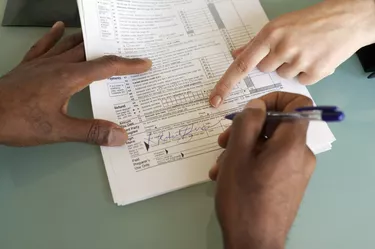
The Internal Revenue Service regards taxi drivers as self-employed and are classified as a sole proprietor of a business. If a taxi driver leases his cab from a fleet owner, he must file two different forms, Schedule C (Form 1040) and Schedule SE (Form 1040). If the taxi driver owns his own cab then he must also file Form 4562 in addition to the two previous forms. It is important to complete the forms in the following order: Schedule C (Form 1040), Form 4562 (if applicable), and then Schedule SE (Form 1040).
Step 1
Download the forms, schedules, and instructions you need from the IRS website, http://www.IRS.gov. Every IRS form and schedule has its own instruction manual that provides line-by-line instructions for completing the form. Be aware that on the IRS website, a form and its corresponding instruction manual are two different files that must be downloaded individually.
Video of the Day
Step 2
Fill out Schedule C (Form 1040). This schedule is used by taxi drivers to declare their income and expenses. Income is the total amount of fares collected. A driver who owns his cab and rents it to another driver when the owner is off duty must declare the rental income. Expenses include the lease fees paid to the fleet owner as well as gas, maintenance, and washing. Note that Schedule C will not tell you how much tax you owe; that is determined by Schedule SE (Form 1040).
Step 3
Complete Form 4562 if you own your own taxi cab, rather than leasing the cab from a fleet owner. You must file Form 4562 to determine the depreciation allowance for your vehicle. The depreciation of the cab is based on the number of miles driven, the age of the car, and any damage that the car may have had. Complete this form accurately because as the depreciation allowance goes higher, the amount of tax you will owe goes lower. Do not file Form 4562 if you do not own your own cab.
Step 4
Use Schedule SE (Form 1040) to determine the amount of taxes you owe. The amount of taxes you pay will determine the amount of Social Security benefits that you will receive. Taxi drivers who do not pay income tax are not eligible for Social Security benefits.
Step 5
Send your completed tax return to the appropriate IRS office. Where you mail your tax return depends on where you live. You can find out where to mail your return go to the IRS.gov website.
Tip
The IRS provides live telephone support for questions about how to prepare your tax forms. The toll-free number is (800) 829-1040, from 7 a.m. to 10 p.m. (in all time zones), Monday through Friday.
If telephone support is not adequate, you can go to an IRS Taxpayer Assistance Center for in-person assistance. You can find the nearest Taxpayer Assistance Center at http://www.IRS.gov/localcontacts/index.html.
Things You'll Need
Copies of passenger receipts showing mileage and fare
Receipts for gasoline and vehicle maintenance
Rental receipts from fleet owner (if applicable)
Video of the Day